The History of C’s the Day: How Sparkleponies Came to Matter
From Pre-Conference Workshop to CCCC Task Force
C’s the Day has an intriguing history, one that showcases the game’s gradual progression from an idea birthed in a pre-conference workshop to a fully fledged augmented reality game supported by the Conference on College Composition and Communication (CCCC). The information provided here walks readers through this rich history of C’s the Day. C’s the Day began as an idea borne out of a pre-conference Wednesday workshop at CCCC in 2009. Stephanie attended this first-ever workshop in the Play/Write series, titled “Play/Write: Connecting Games Research to Composition and Rhetoric Studies.” Led by Alice Robison (now Daer), Douglas Eyman, Zachary Waggoner, J. James Bono, and Annette Vee, the first iteration of Play/Write asked workshop participants to partake in the creation of an original game that would then be scored by workshop leaders. During the second half of the workshop, participants and leaders discussed Confarganon, a conference scavenger hunt game modeled in part on popular alternate reality games (such as I Love Bees, 2004). Confarganon was play-tested in its beta form during the 2009 CCCC, and Suzanne Blum-Malley was the first winner.
 Suzanne Blum-Malley, Confarganon winner, holds up her name tag at CCCC
Suzanne Blum-Malley, Confarganon winner, holds up her name tag at CCCCC’s the Day today acknowledges that the game’s current “core concepts were incubated” in Confarganon, which we can see as an early beta test of sorts for the game as we now know it (“Origins and Purpose,” 2014).
After the success of Confarganon, excitement about the possibilities of embedding games into the conference continued. Multiple sessions at the 2010 CCCC focused on games as a result. Stephanie, for example, participated with fellow game enthusiasts in a panel presentation titled “Writing Lessons from Gamespace: Playing with Rhetoric and Rhetoricizing with Play”; the co-chairs, Wendi Jewell (now Sierra) and Scott Reed, as well as speaker Jill Morris would all go on to collaboratively create C’s the Day along with Mary Karcher, Sheryl Ruszkiewicz, Doug Eyman, and Kelli Centrelli. Play/Write 2.0 was offered as a half-day Wednesday workshop; ten additional panel sessions along with one special interest group on serious games illustrated the field’s growing interest in the potentials for games in rhetoric and composition.
A second major conference in the field of rhetoric and composition, the 2010 Computers & Writing (C&W) conference, also showcased much of this excitement. Games were embedded deeply into C&W 2010: Virtual Worlds@Purdue, from a games-based installation (“Sam and Dave’s Game-o-Rama”) to the Meetü social networking game, described as “the Conference’s social networking game, which is designed to help people make connections, mentor, orient, hobnob, plot, and make or catch up with friends” (“Program of Computers & Writing 2010,” 2010, p. 7).
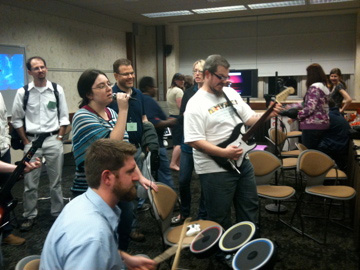
Players at the 2010 Computers & Writing Game-o-Rama
The variety of panel sessions, workshops, and mini-workshops on games was large enough to allow for games and gaming to be identified as an official conference program strand that year.
One pivotal roundtable presentation at C&W 2010 was Amy C. Kimme Hea, Josh Zimmerman, and Sara Howe’s “Press ‘Start’: Critical Reflections on the Development and Deployment of a Large-Scale Alternate Reality Game (ARG).” The presenters, all of the University of Arizona, offered
a discussion of issues related to the development and deployment of an original large-scale alternative reality game—‘The Institute’—constructed as part of a 300+ lecture honors course on memory. Our three presentations . . . offer[ed] reflections on the theoretical and practical concerns related to the potentials and constraints of ARGs as an integral part of university education (“Program of Computers & Writing 2010,” 2010, p. 26)
The creators of C’s the Day noted that the “Press ‘Start’” roundtable prompted them to start “asking how we could use similar concepts to promote productive and playful collisions among rhetoric, composition, and game studies” (“Origins and Purpose,” 2014, n.p.). That ethos of productive yet playful has been a guiding principle for the game ever since.
From these foundational moments at two of the major conferences in our field, C’s the Day: An Augmented Reality Game emerged. The 2011 CCCC in Atlanta featured Play/Write 3.0 and the debut of C’s the Day, alternately dubbed “Sparklepony Quest 2011.”
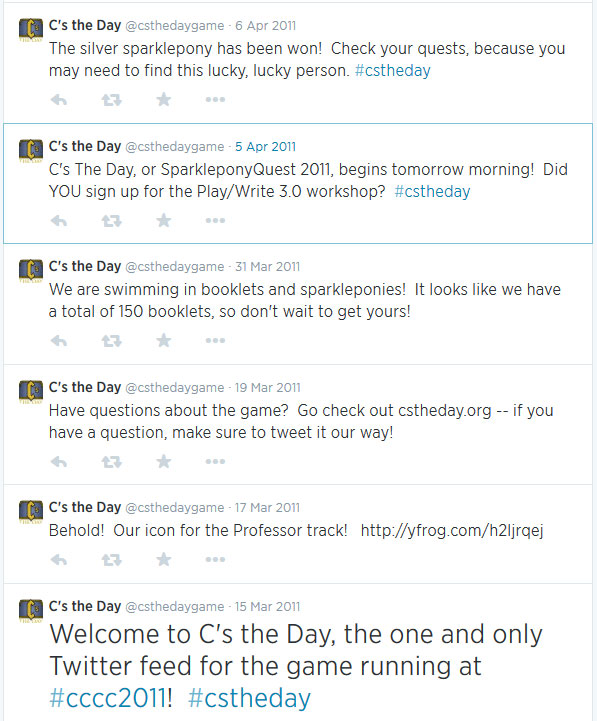
The C’s the Day official Twitter Feed’s earliest tweets
Jenn Stewart and Kyle Stedman were two of the three winners of C’s the Day in 2011, and Stedman would go on to claim his prize—a guaranteed, non-peer-reviewed publication opportunity in Kairos: Rhetoric, Technology, and Pedagogy—in a co-authored piece called “Ode to Sparklepony: Gamification in Action” (written with C’s the Day co-creator Wendi Sierra). Even those who didn’t win enjoyed completing tasks and earning stamps in their game booklet toward the pursuit of an elusive sparklepony, one of the smaller game prizes. (We detail the evolution and significance of sparkleponies later in this webtext.)
The first official year of C’s the Day was a success, and the conference game began its second year with official inclusion in the 2012 CCCC Program Booklet.
C’s the Day, now in its second year, is waiting for players! C’s the Day draws on the inherently social dimensions of play by encouraging players/conference attendees to take up a more active role in creating their experiences. This game provides a great way for newcomers to experience the range of events that C’s has to offer, gives experienced conference-goers a whole new vantage on their time, and encourages both parties to experience the conference in a unique way.
The name is “C’s the Day: An Augmented Reality Game” and the url is http://cstheday.org/ The designers/organizers are:
Doug Eyman, George Mason University
Mary Karcher, Wayne State University
Jill Morris, Frostburg State University
Scott Reed, Georgia Gwinnett College
Sheryl Ruszkiewicz, Baker College
Wendi Sierra, North Carolina State University
Jameson Hogan, North Carolina Sate University
Visit us at our table near the Registration Desk in the America’s Convention Center, Exhibit Hall 1.
Program booklet from the 2012 Conference on College Composition and Communication
The 2013 CCCC Chair’s Letter from Chris Anson highlighted another important moment in the history of C’s the Day: its official status as a task force, further cementing the Conference on College Composition and Communication’s support of the game. Anson’s letter noted that “the highly successful augmented reality game held at the past three CCCC Conventions” led to the creation of a task force that would “make recommendations for sustaining the initiative, reviewing its success on an ongoing basis, and creating a similar game for the NCTE [National Council of Teachers of English] Convention” (pp. 368–369). The early and ongoing support for C’s the Day by the national CCCC organization has helped cement its status at the conference, giving it an ethos akin to the Newcomers’ Coffee Hour, Computer Connection, Undergraduate Poster Session, and other officially sponsored events presented yearly.
The Sparklepony and Why it MattersStephanie has two sparkleponies. Jennifer has one. Each of us treasures our sparkleponies. The front page of this webtext showcases a variety of individuals in the field of rhetoric and composition proudly displaying their sparkleponies. Some are giant, some are small and can be pinned on a conference name badge, and some are in between. Each is colorful and sparkly, some festooned with feathers, ribbons, or jewels, and all have small googly eyes. Just as C’s the Day has gone through multiple iterations, being fine-tuned each year, the sparklepony—now a material signifier of the game itself—has similarly evolved. “The origin of the sparklepony is more complicated than us deciding to pass out glittering horses at the C’s because it’s funny,” stated Jill Morris in an interview (below) with the authors of this webtext. This section of the webtext attempts to address the question that multiple participants in Sparklegate came to focus on: Where did these sparkleponies come from and why do they matter?
Many of the creators of C’s the Day are also World of Warcraft enthusiasts. Thus, in 2010 when Collin Gifford Brooke referenced the World of Warcraft Celestial Steed as an example in his conference talk at Computers & Writing, the C’s the Day sparklepony prize began to take shape. Wendi Sierra described in her interview with us how the sparklepony emerged from a mention in Brooke’s talk to a fully fledged collectible item awarded for playing the game. (Transcript available here.)
Sierra on Ponies
Essentially, the Celestial Steed is a World of Warcraft (WoW) in-game purchase, a flying mount that can be bought for $25.
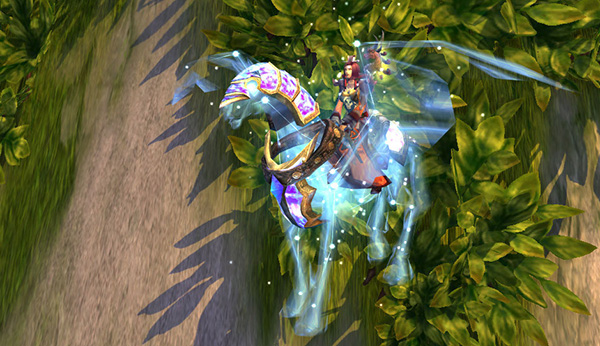
The World of Warcraft Celestial Steed, the original “sparklepony”
One of the most controversial items ever to be offered by Blizzard Entertainment (the makers of WoW), this mount was divisive because previous flying mounts could only be received through in-game effort, such as completing a particular quest or achieving a certain reputation level. The Celestial Steed (quickly and somewhat derisively dubbed “Sparkle Pony” by WoW players) was the first in-game mount that could simply be purchased outright; no achievements were required. It was a massively profitable success for Blizzard; when first released, the company’s profits were estimated at $500,000 per hour (Cifaldi, 2010).
The sparklepony, a viral success for Blizzard in the World of Warcraft game, also spread at the 2010 Computers & Writing conference. After listening to Brooke’s presentation, Jill Morris and Mary Karcher tweeted “We want a sparklepony!” Morris noted in her interview with us,
And then a bunch of other people, even people who were not in the same room, also said they wanted a sparklepony. And Dawn Armfield, who was sitting behind me, said she wanted one too. . . . It spread. It became viral instantly at that conference.
Morris on Ponies (Transcript available here.)
Later that day, she said, the organizers of C’s the Day met to plan the game—to develop quest lines, achievements, and prizes that they would give out: “And we joked about giving out sparkleponies. . . . Six months later, people on Twitter were still saying ‘If you do this game, you have to make sparkleponies.’” As with many other elements of the C’s the Day game, the sparkleponies were originally created in response to the audience’s suggestions. The players of C’s the Day, much like the buyers of the Celestial Steed, drove the demand for the sparklepony—it was never meant to be more than a simple in-joke until the game creators realized that users actually wanted sparkleponies.
The first C’s the Day sparklepony was crafted to look as much like the WoW Celestial Steed as possible, with mesh wings and no eyes. (Morris described it as “creepy looking.”) Later iterations that were dipped in paint, then glitter, and with googly eyes stuck on them were much more popular. These ponies were medium-sized, a little bit larger than the average person’s hand.
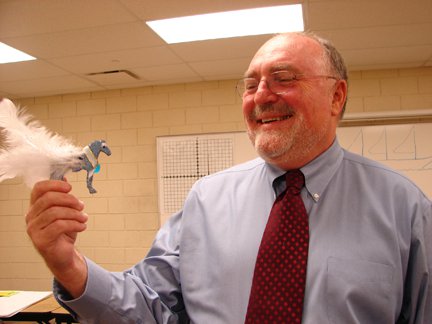
Dr. Lester Faigley holds a medium sparklepony
Larger versions were offered as grand prizes for players who have won the game in the past, like Jenn Stewart and Kyle Stedman. Because the medium-sized horse forms were discontinued a few years ago, today’s players can receive small versions of the sparkleponies that can be pinned onto a conference name badge or a shirt. Many players name their ponies: Stedman’s grand prize pony is Victor, “a purposefully nonreferential name that could refer to more than one field luminary” (Stedman, 2011). Stewart named her two ponies: The smaller one she received for playing the game in 2011 is Gertrude, and her “SuperSparklePony” that she received as a grand prize winner that year is Floyd (Stewart, 2011). The sparklepony is thus one of the more visible (and controversial) tangible prizes to reward players of the C’s the Day game who achieve certain levels within the game. (Players can also collect limited-edition trading cards with the names of respected theorists, journals, and key terms as part of the game.)
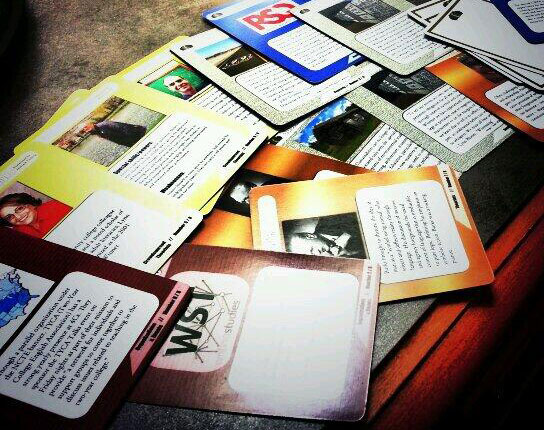
A selection of C’s the Day trading cards
Small ponies made from wooden craft-store forms, painted and festooned with glitter, googly eyes, and other embellishments would not immediately strike most readers as valuable currency. Why would the audience of C’s the Day clamor for little glittery ponies? The sparkleponies quickly became coveted game prizes for C’s the Day, in part because of their limited status and in part because they became a physical manifestation of support for the game itself. As Mike Edwards (2014) articulated, the sparkleponies, as “material instances of in-game digital objects became physical objects of value: scholars interested in the blur between digital and material worlds, including myself, coveted them.” Indeed, in 2014 during “Sparklegate,” past C’s the Day players, supporters, and creators posted pictures of themselves and their sparkleponies in a show of virtual support in Facebook, Twitter, and various blogs.
As Alex Layne (2014) argued on the popular games blog Not Your Mama’s Gamer,
I don’t actually give a shit about sparkleponies as sparkleponies. What I do care about is what they mean for the field. What I do care about is that people who do care about things have the space and freedom to explore them. What I do care about is that we don’t back down when people challenge our work out of fear. What I care about, more than anything, is that we recognize the rhetorical tradition we come from is flawed, and that sparkleponies, as frivolous as they may seem, represent something absolutely critical for the future of rhetoric.
For Layne and others like her, the sparklepony as a physical object is not really the thing that matters; truly, the creators of C’s the Day could have created any number of other limited-edition objects for which players could compete. (In fact, Jill Morris shared with us that other World of Warcraft pets have been made in sparklepony fashion—glitter and googly eyes on wooden forms like crocodiles and seahorses.)
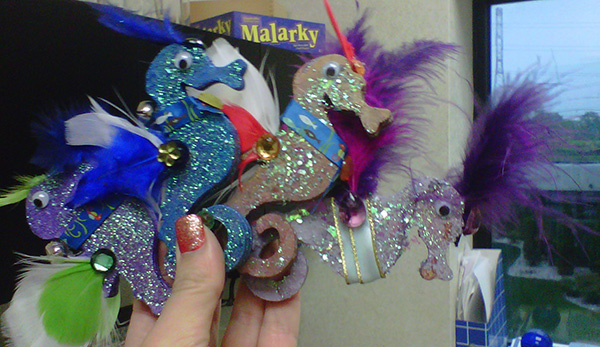
The sparkleponies could just have easily been sparkleseahorses, but that doesn’t roll off the tongue as neatly
It’s not really the pony-as-object that matters. But the sparklepony transcends its material form to stand for abstract ideas that matter in our field. The sparklepony forces us to consider questions about what ideas and whose interests deserve respect in rhetoric and composition.